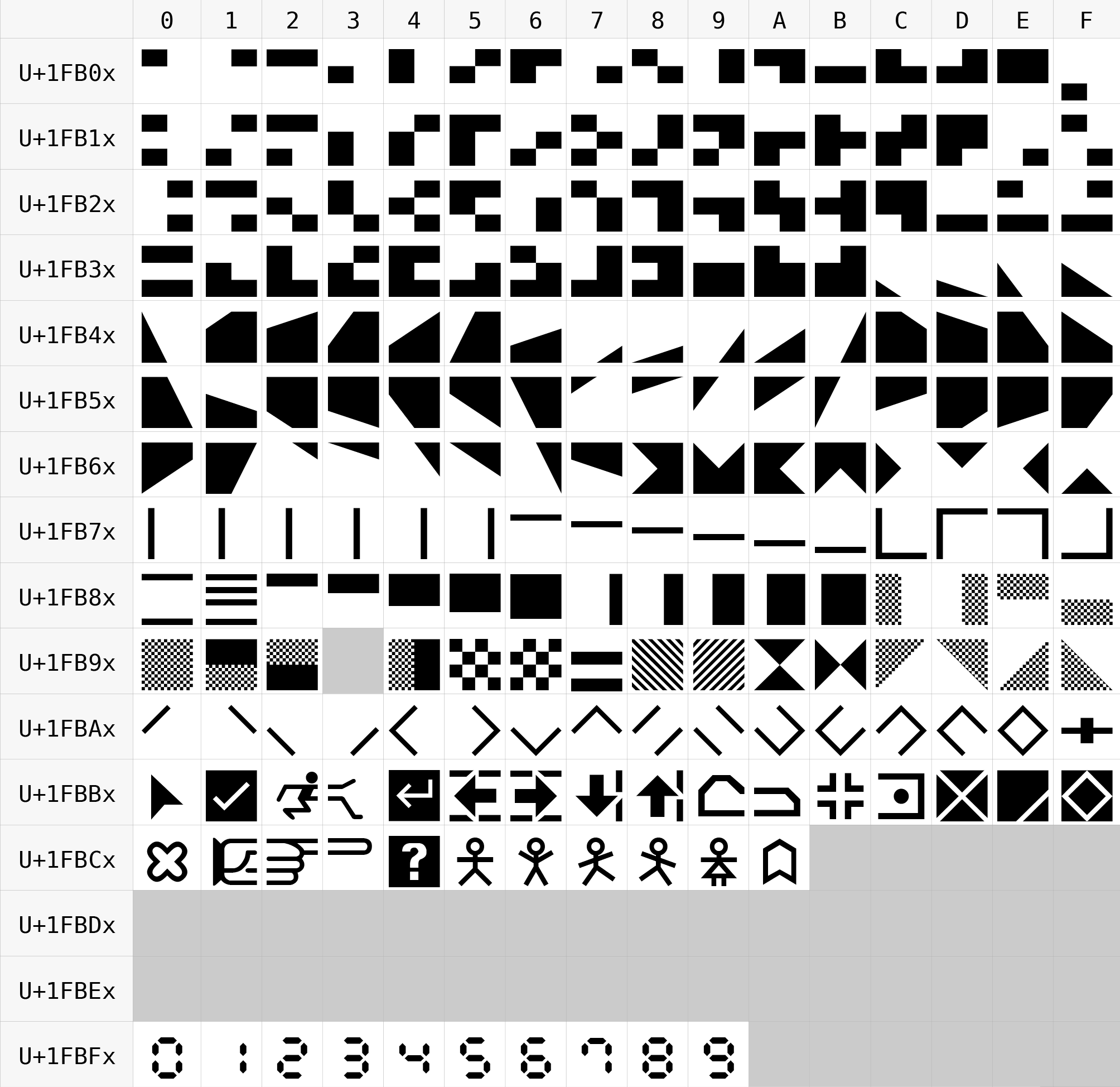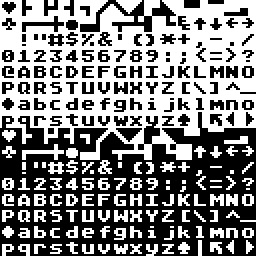|
Symbols For Legacy Computing
Symbols for Legacy Computing is a Unicode block containing graphic characters that were used for various home computers from the 1970s and 1980s and in Teletext broadcasting standards. It includes characters from the Amstrad CPC, MSX, Mattel Aquarius, RISC OS, MouseText, Atari ST, TRS-80 Color Computer, Oric, Texas Instruments TI-99/4A, TRS-80, Minitel, Teletext, ATASCII, PETSCII, ZX80, and ZX81 character sets, as well as semigraphics characters. Block The image below is provided as quick reference for these symbols on systems that are unable to display them directly: : History The following Unicode-related documents record the purpose and process of defining specific characters in the Symbols for Legacy Computing block: See also * Supplemental Arrows-C Unicode block characters and * Block Elements Block Elements is a Unicode block containing square block symbols of various fill and shading. Used along with block elements are box-drawing characters, shade character ... [...More Info...] [...Related Items...] OR: [Wikipedia] [Google] [Baidu] |
Script (Unicode)
In Unicode, a script is a collection of Letter (alphabet), letters and other written signs used to represent textual information in one or more writing systems. Some scripts support one and only one writing system and Written language, language, for example, Armenian language, Armenian. Other scripts support many different writing systems; for example, the Latin script in Unicode, Latin script supports English alphabet, English, French alphabet, French, German alphabet, German, Italian alphabet, Italian, Vietnamese language, Vietnamese, Latin alphabet, Latin itself, and several other languages. Some languages make use of multiple alternate writing systems and thus also use several scripts; for example, in Turkish language, Turkish, the Ottoman Turkish alphabet, Arabic script was used before the 20th century but transitioned to Latin in the early part of the 20th century. For a list of languages supported by each script, see the list of languages by writing system. More or less co ... [...More Info...] [...Related Items...] OR: [Wikipedia] [Google] [Baidu] |
Minitel
The Minitel was a videotex online service accessible through telephone lines, and was the world's most successful online service prior to the World Wide Web. It was invented in Cesson-Sévigné, near Rennes in Brittany, France. The service was rolled out experimentally on 15 July 1980 in Saint-Malo, France, and from autumn 1980 in other areas, and introduced commercially throughout France in 1982 by the PTT (Postes, télégraphes et téléphones (France), Postes, Télégraphes et Téléphones; divided since 1991 between Orange S.A., France Télécom and La Poste (France), La Poste)."Minitel: The rise and fall of the France-wide web" Hugh Schofield, ''BBC News Magazine'' (Paris), 27 June 2012. From its early days, users could make online purchases, make train reservations, check stock price ... [...More Info...] [...Related Items...] OR: [Wikipedia] [Google] [Baidu] |
Supplemental Arrows-C
Supplemental Arrows-C is a Unicode block A Unicode block is one of several contiguous ranges of numeric character codes ( code points) of the Unicode character set that are defined by the Unicode Consortium for administrative and documentation purposes. Typically, proposals such as the ... containing stylistic variants, weights, and fills of standard directional arrows. Block History The following Unicode-related documents record the purpose and process of defining specific characters in the Supplemental Arrows-C block: References {{reflist Unicode blocks ... [...More Info...] [...Related Items...] OR: [Wikipedia] [Google] [Baidu] |
ISO/IEC JTC 1/SC 2
ISO/IEC JTC 1/SC 2 Coded character sets is a standardization subcommittee of the Joint Technical Committee ISO/IEC JTC 1 of the International Organization for Standardization (ISO) and the International Electrotechnical Commission (IEC), that develops and facilitates standards within the field of coded character sets. The international secretariat of ISO/IEC JTC 1/SC 2 is the Japanese Industrial Standards Committee (JISC), located in Japan. SC 2 is responsible for the development of the Universal Coded Character Set (ISO/IEC 10646) which is the international standard corresponding to the Unicode Standard. History ISO/IEC JTC 1/SC 2 was established in 1987, originally with the title “Character Sets and Information Coding,” with the area of work being, “the standardization of bit and byte coded representation of information for interchange including among others, sets of graphic characters, of control functions, of picture elements and audio information coding of text for proces ... [...More Info...] [...Related Items...] OR: [Wikipedia] [Google] [Baidu] |
International Committee For Information Technology Standards
The InterNational Committee for Information Technology Standards (INCITS), (pronounced "insights"), is an ANSI-accredited standards development organization composed of Information technology developers. It was formerly known as the X3 and NCITS. INCITS is the central U.S. forum dedicated to creating technology standards. INCITS is accredited by the American National Standards Institute (ANSI) and is affiliated with the Information Technology Industry Council, a global policy advocacy organization that represents U.S. and global innovation companies. INCITS coordinates technical standards activity between ANSI in the US and joint ISO/IEC committees worldwide. This provides a mechanism to create standards that will be implemented in many nations. As such, INCITS' Executive Board also serves as ANSI's Technical Advisory Group for ISO/IEC Joint Technical Committee 1. JTC 1 is responsible for International standardization in the field of information technology. INCITS operates thro ... [...More Info...] [...Related Items...] OR: [Wikipedia] [Google] [Baidu] |
Symbols For Legacy Computing Unicode Block
A symbol is a mark, sign, or word that indicates, signifies, or is understood as representing an idea, object, or relationship. Symbols allow people to go beyond what is known or seen by creating linkages between otherwise very different concepts and experiences. All communication (and data processing) is achieved through the use of symbols. Symbols take the form of words, sounds, gestures, ideas, or visual images and are used to convey other ideas and beliefs. For example, a red octagon is a common symbol for "STOP"; on maps, blue lines often represent rivers; and a red rose often symbolizes love and compassion. Numerals are symbols for numbers; letters of an alphabet may be symbols for certain phonemes; and personal names are symbols representing individuals. The variable 'x', in a mathematical equation, may symbolize the position of a particle in space. The academic study of symbols is semiotics. In cartography, an organized collection of symbols forms a legend for a map. ... [...More Info...] [...Related Items...] OR: [Wikipedia] [Google] [Baidu] |
Unicode
Unicode, formally The Unicode Standard,The formal version reference is is an information technology Technical standard, standard for the consistent character encoding, encoding, representation, and handling of Character (computing), text expressed in most of the world's writing systems. The standard, which is maintained by the Unicode Consortium, defines as of the current version (15.0) 149,186 characters covering 161 modern and historic script (Unicode), scripts, as well as symbols, emoji (including in colors), and non-visual control and formatting codes. Unicode's success at unifying character sets has led to its widespread and predominant use in the internationalization and localization of computer software. The standard has been implemented in many recent technologies, including modern operating systems, XML, and most modern programming languages. The Unicode character repertoire is synchronized with Universal Coded Character Set, ISO/IEC 10646, each being code-for-code id ... [...More Info...] [...Related Items...] OR: [Wikipedia] [Google] [Baidu] |
Semigraphics
Text-based semigraphics or pseudographics is a primitive method used in early text mode video hardware to emulate raster graphics without having to implement the logic for such a display mode. There are two different ways to accomplish the emulation of raster graphics. The first one is to create a low-resolution all points addressable mode using a set of special characters with all binary combinations of a certain subdivision matrix of the text mode character size; this method is referred to as block graphics, or sometimes mosaic graphics. The second one is to use special shapes instead of glyphs (letters and figures) that appear as if drawn in raster graphics mode, sometimes referred to as semi- or pseudo-graphics; an important example of this is box-drawing characters. Semigraphical characters (including some block elements) are still incorporated into the BIOS of any VGA compatible video card, so any PC can display these characters from the moment it is turned on, even whe ... [...More Info...] [...Related Items...] OR: [Wikipedia] [Google] [Baidu] |
ZX81 Character Set
The ZX81 character set is the character encoding used by the Sinclair Research ZX81 family of microcomputers including the Timex Sinclair 1000 and Timex Sinclair 1500. The encoding uses one byte per character for 256 code points. It has no relationship with previously established ones like ASCII or EBCDIC, but it is related though not identical to the character set of the predecessor ZX80. Printable characters The character set has 64 unique glyphs present at code points 0–63. With the most significant bit set the character is generated in inverse video; corresponding to code points 128–191. These 128 values are the only displayable ones allowed in the video memory (known as the display file). The remaining code points (64–127 and 192–255) are used as control characters such as 118 for newline or, uniquely to Sinclair BASIC, for keywords, while some are unused. The small effective range of only 64 unique glyphs precludes support for Latin lower case letters, and many s ... [...More Info...] [...Related Items...] OR: [Wikipedia] [Google] [Baidu] |
ZX80 Character Set
The ZX80 character set is the character encoding used by the Sinclair Research ZX80 microcomputer with its original 4K BASIC ROM. The encoding uses one byte per character for 256 code points. It has no relationship with previously established ones like ASCII or EBCDIC, but it is related though not identical to the character set of the successor ZX81. Printable characters The character set has 64 unique glyphs present at code points 0–63. With the most significant bit set the character is generated in inverse video; corresponding to code points 128–191. These 128 values are the only displayable ones allowed in the video memory (known as the display file). The remaining code points (64–127 and 192–255) are used as control characters or Sinclair BASIC keywords, while some are unused. The small effective range of only 64 unique glyphs precludes support for Latin lower case letters, and many symbols used widely in computing such as the exclamation point or the at sign. Ther ... [...More Info...] [...Related Items...] OR: [Wikipedia] [Google] [Baidu] |
PETSCII
PETSCII (''PET Standard Code of Information Interchange''), also known as CBM ASCII, is the character set used in Commodore Business Machines (CBM)'s 8-bit home computers, starting with the PET from 1977 and including the C16, C64, C116, C128, CBM-II, Plus/4, and VIC-20. History The character set was largely designed by Leonard Tramiel (the son of Commodore CEO Jack Tramiel) and PET designer Chuck Peddle. The graphic characters of PETSCII were one of the extensions Commodore specified for Commodore BASIC when laying out desired changes to Microsoft's existing 6502 BASIC to Microsoft's Ric Weiland in 1977.A Conversation with Chuck Peddle, Bil Herd, Jeri Ellsworth - part 3 (2009 videoconference, 06:30) The VIC-20 used the same pixel-for-pixel |
ATASCII
The ATASCII character set, from ''ATARI Standard Code for Information Interchange'', alternatively ''ATARI ASCII'', is the variation on ASCII used in the Atari 8-bit family of home computers. The first of this family are the Atari 400 and 800, released in 1979, and later models were released throughout the 1980s. The last computer to use the ATASCII character set is the Atari XEGS which was released in 1987 and discontinued in 1992. The Atari ST family of computers use the different Atari ST character set. Like most other non-standard ASCIIs, ATASCII has its own special block graphics symbols (arrows, blocks, circles, line segments, playing card suits, etc.) corresponding to the control character locations of the standard ASCII table (characters 0–31), and a few other character locations. Control characters The main difference between standard ASCII and ATASCII is the use of control characters. In standard ASCII, a character in the range 0 to 31 is construed as a command, ... [...More Info...] [...Related Items...] OR: [Wikipedia] [Google] [Baidu] |






